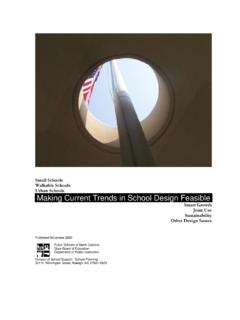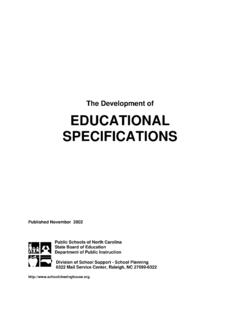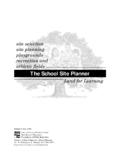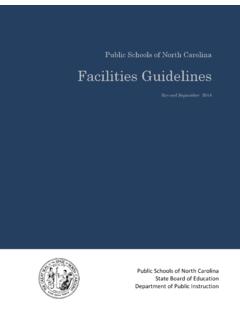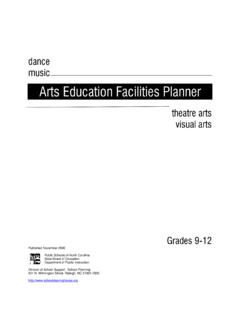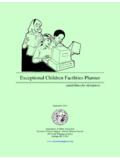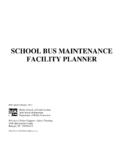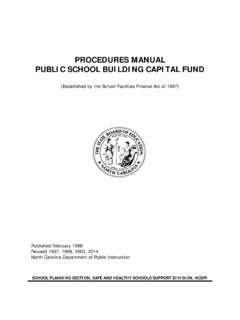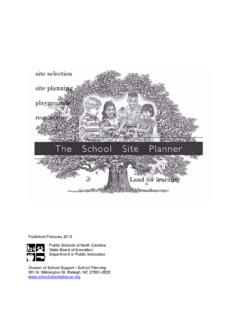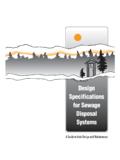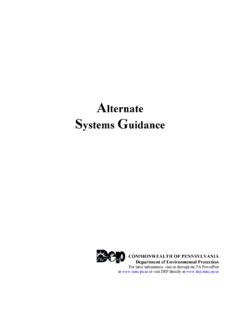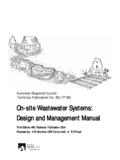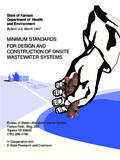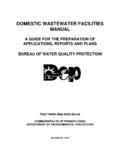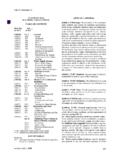Transcription of project development Plans and specifications …
1 project development Plans and specifications design and Construction Procedures post construction directory of agencies Revised October 2007 Division of School Support School Planning 6319 Mail Service Center, Raleigh, NC 27699-6319 Voice 919-807-3554 Fax 919-807-3558 iiiForeword Providing public school facilities that support and enhance efforts of children to learn and of teachers to teach is a continuing challenge to local school administrative units across our state. Research clearly indicates a relationship between the school facility and climate, order, and safety that can result in positive benefits to the educational endeavor. Creating a physical environment conducive to safety and success for every child is a goal we all share. Many school administrators and school facilities designers are involved infrequently in the process of planning and building facilities and are, therefore, not fully familiar with the nuances of moving through the process in orderly and efficient sequence.
2 This publication should prove particularly helpful when addressing current and emerging facilities needs. We hope you find it useful. Howard N. Lee, Chair June St. Clair Atkinson, State Superintendent State Board of Education North Carolina Department of Public Instruction In compliance with federal law, including the provisions of Title IX of the Education Amendments of 1972, the North Carolina Department of Public Instruction does not discriminate on the basis of race, sex, religion, color, national or ethnic origin, age, disability, or military service in its policies, programs, activities, admissions or employment. Inquiries or complaints should be directed to: the Office of Curriculum and School Reform Services 6307 Mail Service Center Raleigh, NC 27699-6307 Telephone (919) 807-3761; fax (919) 807-3767 ivAcknowledgments The Department of Public Instruction gratefully acknowledges the contributions of the following, without which the development of this publication would have been difficult.
3 Steve Taynton, AIA, Chief, School Planning Section, Department of Public Instruction, Raleigh, NC. Primary author for this edition. Roger Ballard, AIA, Consulting Architect, School Planning Section, Department of Public Instruction, Raleigh, NC. Daniel Boyette, Statistical Research Asst., School Planning Section, Department of Public Instruction, Raleigh, NC. Bob Bryan, , Consulting Engineer, School Planning Section, Department of Public Instruction, Raleigh, NC. Long Chang, , Consulting Engineer, School Planning Section, Department of Public Instruction, Raleigh, NC. Johnny Clark, Consulting Engineer, School Planning Section, Department of Public Instruction, Raleigh, NC. Greg Flynn, Consulting Architect, School Planning Section, Department of Public Instruction, Raleigh, NC. Ken Phelps, School Planning Consultant, School Planning Section, Department of Public Instruction, Raleigh, NC.
4 Pam Ray, Program Assistant, School Planning Section, Department of Public Instruction, Raleigh, NC. vContents Foreword.. iii iv Using the Projects Reviewed and Not Reviewed by School Planning ..2 project development Schematic design ..3 design development ..4 Construction Documents ..5 Plans and specifications ..7 Department of Public Department of Department of Environment and Natural Resources ..8 Wastewater Systems ..8 School Cafeterias ..9 Soil Sedimentation and Erosion Control ..9 Water Supply Systems ..10 Wetlands ..17 Department of Transportation ..11 Historical Commission ..11 Army Corps of Engineers ..12 Post-Construction Property Accounting ..13 Prototype School design Special Cases .. 14 Purchase and Installation of Modular Units ..14 Pre-engineered Structures and Modular Building Buildings for Charter Public Schools.
5 15 Public School Building Contracts ..16 Resources ..18 Appendix ..20 Directory of Agencies ..22 General Statutes ..28 1 Introduction Local boards of education and school facilities designers, in meeting classroom facilities needs pursuant to GS 115C-521, can experience confusion and frustration with the myriad of requirements and regulations encountered in the construction and renovation processes. This may be particularly true in school systems not regularly engaged in building programs. Reviews, certifications and approvals that can ensure safe and sanitary environments for learning can also result in expensive delays in project completion, where due care and planning are not exercised. This publication identifies a number of procedures, regulations, and agencies associated with the construction of school facilities and provides information that can expedite logical and efficient planning.
6 Since both regulations and agencies tend to change with time, the contents of the guide should not be assumed to be all-inclusive, but rather current examples based upon recent school construction experiences in the state. Since final responsibility for meeting all applicable codes and other regulations rests with the owner, a directory of agencies is included in the Appendix. In addition, staff with the School Planning Section of the Department of Public Instruction may be reached at (919) 807-3554 for consultation. Using the publication This publication sets forth typical procedures for the planning and construction of public school facilities. It is neither comprehensive nor all-inclusive, but promotes an initial awareness of procedures, regulations, and agencies associated with the design and construction processes. The information herein in no way supersedes federal, state or local codes or regulations.
7 As facilities planning is initiated, the related section(s) of the publication should be consulted for procedures that are suggested or that may be required during each phase of the project , through completion. Additionally, early involvement of design professionals who are accustomed to dealing with regulatory agencies can significantly reduce the possibility of unnecessary delays. Agency representatives, identified in the Appendix, should be consulted regarding specific requirements and approval processes.\ School Planning on the Web Many, more detailed guidelines and publications are available for download and printing on the school planning website: 2 Review of Projects by NC DPI School Planning Types of Projects We Review All New Construction, Renovations, Additions New athletic fields, grandstands, press box, field houses, concession stands, dugouts, etc.
8 New and Relocated Modular classroom units, ramps, steps, walkways, etc. including foundations Repair or replacement of structural systems New dropped ceiling in existing schools Replacing Windows or Doors Demolition of existing school building Reroofing, over-roofing Relocating partitions; adding or deleting doors New Parking or Drives Technology system, security system, CCTV, etc. Improvements required by ADA Change-out of plumbing fixtures or change in type of fixtures New domestic water heating system, or upgrade New HVAC systems; new boilers; new chillers; changes in type of system; demo and replacement of air distribution system, etc. Upgrade or redesign HVAC control system New energy conservation system Complete replacement of exist HVAC or plumbing piping systems; extension of existing system Major components of Power Distribution System New lighting systems (interior or exterior) Any new system affecting health, or welfare of students or personnel such as fire suppression, emergency power generation, etc.
9 Types of Projects We Do Not Review Demolition of buildings other than school buildings Roof patching or maintenance. Any repair or maintenance, such as replacing flooring, patching walls, repainting, etc. Repairing asphalt, potholes, etc. or resurfacing existing Upgrades of fire alarms, other existing systems Additions of simple ramps, etc. or signage Plumbing replacements in-kind; replace faucets or other minor components Water heater replacement with same type and size. HVAC equipment replacement in-kind; small air handling or condensing units (5 ton or less); air diffusers and grills; fan, heaters, etc. Replacement of HVAC control components Repair of existing insulation Repair of existing piping Adding electrical outlets to existing systems Replacing or adding lighting fixtures to existing systems Replacement of isolated safety components with new elements meeting code and similar to existing.
10 3 project development phases 115C-521 requires that before a board of education invests any money in any new building, it will first develop Plans based upon consideration of the State Board of Education=s North Carolina Public School Facilities Guidelines, submit those Plans to the State Board for its review and comments, and review the Plans based upon consideration of the comments it receives from the State Board. The School Planning Section in the Division of School Support has been designated the State Board=s representative in that process. For purposes of complying with the intent of this statute, new building is interpreted to include new schools, additions to existing schools, and major renovations; small building projects such as workforce development shops, athletic facilities, field houses, greenhouses, concession stands, press boxes, weight rooms, storage facilities, and bleachers; and modular buildings.
